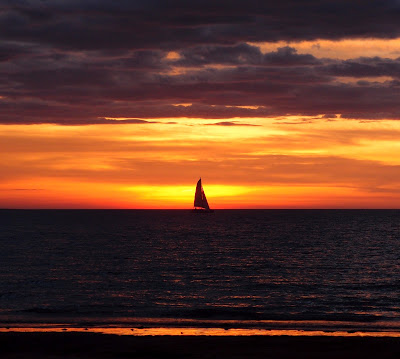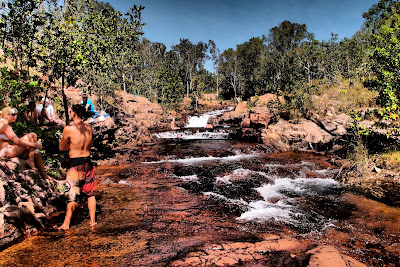When I was planning my RTW trip I had been very curious about the Northern Australia and the outback so I had decided to add Darwin to my Australian itenerary. I arrived there after very exciting
10 days of dancing in Brisbane and the Gold Coast ... feeling very tired. The hot & humid air of Darwin was a nice change after the chilly nights of Queensland - where I had actually managed to develop a cold. So the first couple days in Darwin I just kicked back, enjoyed the heat and did pretty much nothing.
By the third day I was feeling better, happily doing some sightseeing and tanning by the pool. Not bad!
 |
| Hi there! - Possum or the "catkangaroo" as one guy named it |
Cooling down in Litchfield National Park
It tends to get quite hot in the top part of the Northern Territory and winter is actually the best time to visit. Even then the temperatures go above 30 C during the day and stay above 20 C during the night. Bush fires are very common - we even saw plenty of them when we drove out of the city. Sometimes it also gets very humid so you'll spend most of the day under the shade or a fan (or both) or in the pool. The bad thing about the area is that the waters are mostly not safe to swim in. Why? Crocodiles! I think there's a part of "urban legend" to it but they say any pool of water can house a mean croc. I wasn't going to test my luck.
 |
| Warning warning warning..!! |
Luckily there are safe spots to swim in - and beautiful ones too!
Litchfield National Park is one of the most popular sights close to Darwin, just a bit over an hour's drive from the city. I joined four other excited travelers and we rented a car for a nice day trip.
First on the way there we stopped to see the Magnetic Termite Mounds. This area has hundreds of mounds of about 1-2,5m in height and they're all aligned north to south - a termite design feature which aims to minimise the exposure to the sun. Pretty impressive!
 |
| Magnetic Termite Mounds |
 |
| This Cathedral Termite Mound was over 5m tall! |
Finally it was time for the first dip - the Buley Rockhole! These rockpools do attract a lot of people but there are several big and small pools on many levels so you should find a nice spot of your own to chill in. Or to jump in if you're brave enough!
 |
| Buley Rockhole |
 |
| 1, 2, 3, JUMP! |
After cooling down in the rockpools we continued to Florence Falls. At the top you can catch a good view of the entire falls. From there you have to go down quite a few steps but it's worth the walk. The water is very clear and you can spot a lot of fishes - and take a swim with them :)
 |
| Florence Falls from above |
 |
| Photos don't do justice to this spot |
There's still more falls in Litchfield! Tolmer Falls is one of the highest ones, if not the highest. There's a great viewing platform on top looking over to the falls and you can see quite far all around the area. No swimming here though but really worth to stop over.
 |
| Tolmer Falls |
The last one on our itinerary was the Wangi Falls. This was my favourite of the day. The pool is the biggest one and there two great cascades. The one on the left (the smaller) has a "hidden" rockpool you can climb into. You'll find on the right hand side of the cascade, a couple metres above the surface of the pool so it takes a bit of effort to climb in there - do it! It's quite a deep pool so be careful but the water is strangely, and enjoyably, warm; it's like a hot tub for about 4 people!! From the "hot tub" you'll also have an amazing view into the cascade.
The cascade on the right you can swim into - or you can try! You have to approach it from the side as the stream straight in front of it even 10m away is so strong you'll tire yourself before you can make it there! There's something amazing about the feeling of the tons of water pouring over you.
 |
| The massive Wangi Falls - once you swim all the way to the bottom of them you realise how big they really are! |
 |
| Our Litchfield National Park "European team": UK, UK, Germany, Germany, Finland |
A day tour (morning to late afternoon) to Litchfield National Park is best done with your own or rental car. The area is about 100km from Darwin and there are plenty of road signs and parking spots at the falls. The cost for a small car was 75 AUD for the day (including 250 free kms) and the whole trip ended up costing the five of us 30 AUD per person, including the gas. Bring some snacks and water! You can also join one of the numerous organised day trips starting 99 AUD.
There's lots of other tours in the Darwin area: You can go to the Kakadu National Park (you'll mostly need a 4WD car and a couple days), take a flight to Tiwi islands, there's fishing trips, jumping crocodile boat trips and even a croc & snake show in the city. If you have more time you can also catch quite inexpensive flights to Bali.
Darwin in a nutshell
Darwin feels a bit like a border town with its remote location, mixed population and industrial looks. But it's an interesting place with definitely a warm climate and some of the most typical "Australian outback" nature & wildlife easily accessible from the city. The area's history can be seen from with the WWII memorabilia all around the Esplanade and the contemporary architecture brought on by the cyclones that tore the city apart. You'll also find more Aborigine crafts and bars than in most cities. The prices are quite high (hostels and meals) and the internet very slow (free wifi only in the library). But that's not what you would go there for - you'll go there for an outback experience. Darwin... Not my Australian top treat but hey, I did have a great time!
 |
| Enjoy a game of rugby or a picnic in the Esplanade park - site of WWII bombings |
 |
| More of a port town than a beach town - yet there are still a couple beaches in Darwin |





















No comments:
Post a Comment